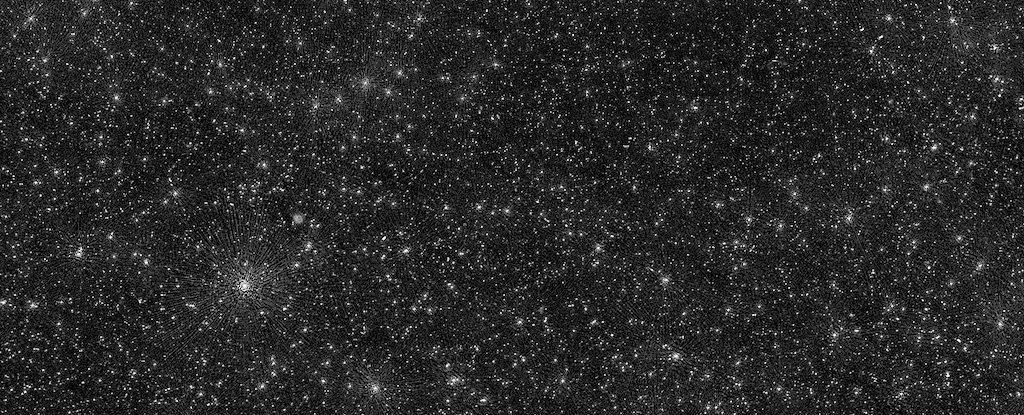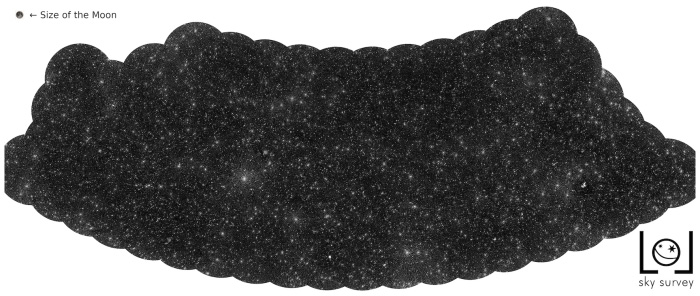
Posted on 02/23/2023 12:56:12 PM PST by Red Badger

Black and white map showing 25,000 black holes These aren't ordinary stars. (LOFAR/LOL Survey)
The image above may look like a fairly normal picture of the night sky, but what you're looking at is a lot more special than just glittering stars. Each of those white dots is an active supermassive black hole.
And each of those black holes is devouring material at the heart of a galaxy millions of light-years away – that's how they could be pinpointed at all.
Released in 2021, this image contains 25,000 such dots, It's the most detailed map to date of black holes at low radio frequencies, an achievement that took years and a Europe-sized radio telescope to compile.
"This is the result of many years of work on incredibly difficult data," explained astronomer Francesco de Gasperin of the University of Hamburg in Germany back in February 2021.
"We had to invent new methods to convert the radio signals into images of the sky."

(LOFAR/LOL Survey)
When they're just hanging out not doing much, black holes don't give off any detectable radiation, making them much harder to find.
When a black hole is actively accreting material – spooling it in from a disc of dust and gas that circles it much as water circles a drain – the intense forces involved generate radiation across multiple wavelengths that we can detect across the vastness of space.
What makes the above image so special is that it covers the ultra-low radio wavelengths, as detected by the LOw Frequency ARray (LOFAR) in Europe. This interferometric network consists of around 20,000 radio antennas, distributed throughout 52 locations across Europe.
Currently, LOFAR is the only radio telescope network capable of deep, high-resolution imaging at frequencies below 100 megahertz, offering a view of the sky like no other.
This data release, covering four percent of the northern sky, was the first for the network's ambitious plan to image the entire northern sky in ultra-low-frequencies, the LOFAR LBA Sky Survey (LoLSS).
Because it's based on Earth, LOFAR does have a significant hurdle to overcome that doesn't afflict space-based telescopes: the ionosphere.
This is particularly problematic for ultra-low-frequency radio waves, which can be reflected back into space. At frequencies below 5 megahertz, the ionosphere is opaque for this reason.
The frequencies that do penetrate the ionosphere can vary according to atmospheric conditions. To overcome this problem, the team used supercomputers running algorithms to correct for ionospheric interference every four seconds. Over the 256 hours that LOFAR stared at the sky, that's a lot of corrections.
This is what has given us such a clear view of the ultra-low-frequency sky.
"After many years of software development, it is so wonderful to see that this has now really worked out," said astronomer Huub Röttgering of Leiden Observatory in the Netherlands.
The results were published in Astronomy & Astrophysics.
A version of this article was first published in February 2021.
Shopping!....................
Just the fact that some black holes are larger than others indicates that there is some theoretical limit to their size.
At some point, the intense gravitational forces compacting the masses that fall past the event horizon, will reach a ‘critical mass’ where they will no longer be able to compress the incoming mass, and will ‘let go’ when more mass is added.
There must be a formula for this........................
In the reporting I’ve seen, I’d rather call it looting.
Do we even know what a black hole is?
Well, yes and no. We know that it is a region of such great energy density that it has a gravitational field so great that nothing that passes a certain distance from the center of it (known as the event horizon) can escape. So that’s the yes part. In the equivalent terms expressed in the language of relativity, it is a region of highly curved spacetime such that the ordinarily space-like coordinate that describes the distance from the black hole center becomes a time-like coordinate instead. This means that not only can nothing escape once it crosses the event horizon, it cannot move freely in any spatial direction, but instead is constrained to fall ever closer to the center. Essentially anything crossing the events horizon falls forever.
That’s the “yes” part. We can make these conclusions based on the Einstein field equations of General Relativity, so we are fairly confident in them. Not only do observations such as these conform to what is predicted by GR, ALL observations of systems in which gravity plays a significant role conform to the predictions of General Relativity. There are no exceptions (as of now). The consequences of GR seem weird, but that is because our normal experience is in an environment where an approximation to them, namely Newtonian gravity, holds to a high degree of accuracy. While the two agree in most everyday situations, there are measurable (but not immediately apparent) effects where they differ, and in all such cases relativity gives the right answer.
Two good examples: very accurate clocks will show different times on earth and in a weaker gravitational field in orbit. This is accounted for by relativity and absent n Newtonian gravity. We know it occurs because our GPS systems require very accurate time measurements to give accurate locations, and the clocks in these systems must be adjusted to account for the gravitational field in the GPS satellites. Another example, if you stand on the ground and shine a light toward the top of a tall building, the light will have a different color when it gets there than it did when it started out. The light will be redder at the top of the building - that is it will have a lower frequency. This effect is too small (and our buildings are too short) to observe.with visible light, but it has been measured with gamma radiation (which has a higher frequency and thus a greater effect).
Now the “no” part. Since nothing can escape from the event horizon, we cannot observe anything inside it. We cannot tell what black holes are made of. We cannot tell what is happening to anything inside the horizon. The observations about curved spacetime and objects being forced to fall forever are from the reference frame of an outside observer. The equations of relativity, as confident as we are about them, simply cannot be applied to the region inside the event horizon in a sensible way. It is fair to say that we don’t know what is inside the black hole. As it turns out, all we can tell about a black hole is its mass, electrical charge and angular momentum. Anything else is impossible to know.
There is a formula, but it does not give an upper limit to the size or mass of a black hole. A black hole is any object smaller than its Schwarzschild radius, which is given by 2GM/c^2, where G is the gravitational constant and c the speed of light. Since (are my previous post) we cannot tell what happens inside the event horizon (anything closer than the Scwarzschild radius), the only sensible size we can attribute to a black hole is this value.
Therefore adding more mass to the black hole does not compress anything further. The radius of the black hole increases linearly with increasing mass. This is quite different than ordinary objects where the volume of the object increases linearly with mass. For ordinary objects this implies a constant density since mass and volume increase in proportion. For black holes the volume increases as the third power of mass (volume is proportional to the third power of the radius, which is directly proportional to mass). Because of this, the mass density of a black hole DECREASES with increased mass - it becomes less compressed, not more.
So, it gets fatter and fatter as more mass accumulates until the event horizon becomes full, and if more mass comes in it pops like a soap bubble?...................
Nope. More mass just makes it keep getting larger. It is pretty interesting (coincidence?) that the Schwarzschild radius of a black hole with the mass of the observable universe is pretty close to the actual radius of the observable universe. That is a black hole with the same mass as everything we can observe would be approximately the same size as what we observe, leading to the question- Do we actually live inside a black hole? This possibility is studied seriously by some theoretical physicists and can actually explain the expansion of the universe from a minimum size.
It’s hard to see, however, how this possibility could ever be confirmed (or refuted) observationally.
Everything that we can see is not all that there is to see...................
Thanks for your well-informed, reasoned considerable and considerate response. You managed to give some definition to an indefinite phenomenon. It was very kind of you.
Disclaimer: Opinions posted on Free Republic are those of the individual posters and do not necessarily represent the opinion of Free Republic or its management. All materials posted herein are protected by copyright law and the exemption for fair use of copyrighted works.